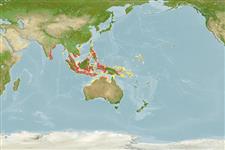>
Syngnathiformes (Pipefishes and seahorses) >
Syngnathidae (Pipefishes and seahorses) > Syngnathinae
Etymology: Hippocampus: Greek, ippos = horse + Greek,kampe = curvature (Ref. 45335); satomiae: This species is named in honour of Miss Satomi Onishi, the dive guide who collected the type
specimens..
Environment: milieu / climate zone / depth range / distribution range
Écologie
marin benthopélagique; non migrateur; profondeur 5 - 20 m (Ref. 79848). Tropical
Western Pacific: Indonesia, Brunei and Malaysia.
Taille / Poids / Âge
Maturity: Lm ? range ? - ? cm
Max length : 1.4 cm SL mâle / non sexé; (Ref. 79848); 1.3 cm SL (female)
Description synthétique
Morphologie | Morphométrie
Rayons mous dorsaux (Total): 13. Extremely small size (height 11 mm, standard length 14 mm); 12 trunk rings; 27–28 tail rings; reduced ossification of inferior and ventral trunk ridges; 13 dorsal fin rays; 9 pectoral fin rays; small or absent anal fin; brooding area in males anterior to anus; well–developed spine on snout between eyes; distinct raised coronet with laterally expanded anterior and posterior flanges ('H–shaped' when viewed from above); snout without a bulbous tip; single gill opening on midline directly behind coronet supported by raised cleithral bone; large spines above eyes (double), laterally on head, on shoulder (cleithral) ring, bordering throat, and on superior trunk ridge (especially well–developed on TrR1–2,5,8 and 12 and TaR4,8,11,14); spines also present on lateral and ventral angles between trunk ridges and rings; spines on superior ridge of first and second trunk rings appear externally as if they are fused (Ref. 79848).
Hippocampus satomiae congregates at night in groups of 3–5 individuals on small seafans, at depths of 15–20 m depth on the bottom below reef overhangs. During the day H. satomiae are difficult to find, even in areas where they are known to occur. At dawn individuals become active. At birth, the young are jet–black, about 3 mm in height and shaped similarly to the adults. They settle on the bottom near to their place of birth (Onishi, pers. comm.). The holotype, collected in October, was pregnant and carrying approximately eight young (Ref. 79848).
Life cycle and mating behavior
Maturité | Reproduction | Frai | Œufs | Fécondité | Larves
Male carries the eggs in a brood pouch (Ref. 205).
Lourie, S.A., R.A. Pollom and S.J. Foster, 2016. A global revision of the seahorses Hippocampus Rafinesque 1810 (Actinopterygii: Syngnathiformes): taxonomy and biogeography with recommendations for further research. Zootaxa 4146(1):1-66. (Ref. 115213)
Statut dans la liste rouge de l'IUCN (Ref. 130435)
Menace pour l'homme
Harmless
Utilisations par l'homme
Plus d'informations
PaysZones FAOÉcosystèmesOccurrencesIntroductionsStocksÉcologieRégime alimentaireÉléments du régime alimentaireConsommation alimentaireRation
Taille/ÂgeCroissanceLongueur-poidsLongueur-longueurFréquences de longueursMorphométrieMorphologieLarvesDynamique des populations larvairesRecrutementAbondanceBRUVS
RéférencesAquacultureProfil d'aquacultureSouchesGénétiqueElectrophoresesHéritabilitéPathologiesTraitementNutrientsMass conversion
CollaborateursImagesStamps, Coins Misc.SonsCiguateraVitesseType de nageSurface branchialeOtolithesCerveauxVision
Outils
Articles particuliers
Télécharger en XML
Sources Internet
Estimates based on models
Preferred temperature (Ref.
123201): 28.3 - 29.3, mean 28.8 °C (based on 771 cells).
Phylogenetic diversity index (Ref.
82804): PD
50 = 0.5000 [Uniqueness, from 0.5 = low to 2.0 = high].
Bayesian length-weight: a=0.00447 (0.00177 - 0.01127), b=3.00 (2.78 - 3.22), in cm total length, based on LWR estimates for this (Sub)family-body shape (Ref.
93245).
Niveau trophique (Ref.
69278): 3.0 ±0.4 se; based on size and trophs of closest relatives
Résilience (Ref.
120179): Haut, temps minimum de doublement de population inférieur à 15 mois (Preliminary K or Fecundity.).
Fishing Vulnerability (Ref.
59153): Low vulnerability (10 of 100).
